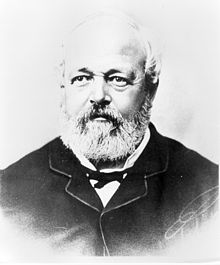Whitehead & Co.
| Robert Whitehead | |
|---|---|
 |
|
| Born |
3 January 1823 Bolton, Lancashire, England, UK |
| Died | 14 November 1905 (aged 82) Shrivenham, Berkshire, England, UK |
| Nationality | British |
| Citizenship | England |
| Spouse(s) | Frances Maria Johnston |
| Children |
|
| Engineering career | |
| Projects | Developed the first self-propelled torpedo |
Robert Whitehead (3 January 1823 – 14 November 1905) was an English engineer, most famous for developing the first effective self-propelled naval torpedo.
He was born in Bolton, England, the son of James Whitehead, a cotton-bleacher, and his wife Ellen Whitehead nee Swift. He trained as an engineer and draughtsman, and attended the Mechanics Institute in Manchester.
His first professional employment was at a shipyard in Toulon, France, for Philip Taylor & Sons, and then as a consultant engineer in Milan, Italy. He then moved to Trieste, on the Adriatic coast of Austria.
Whitehead's work in Trieste was noticed by the owners of Fonderia Metalli, a metal foundry in the nearby city of Fiume (today Rijeka, Croatia). In 1856, Whitehead became manager of the company, and changed its name to Stabilimento Tecnico di Fiume (STF). STF produced marine steam boilers and engines, which were the most modern products of that era. The Austrian Navy was a customer.
In the early 1860s, Whitehead met engineer Giovanni Luppis, who had recently retired to Trieste from the Austrian Navy. Luppis had produced the first prototypes of a self-propelled torpedo in 1860, which he called the "coast saviour" (Italian: Salvacoste) (Croatian: Spasilac obale). Luppis' device was a low-profile surface boat, propelled by compressed air, and controlled by ropes from the land. Whitehead and Luppis formed a partnership to perfect the torpedo as an effective weapon.
Whitehead's initial torpedo experiments were conducted with the help of his 12-year-old son, John, and a workman, Annibale Ploech. They discarded Luppis' concept of shore launch and control for an unguided weapon launched from a ship on a straight line at the target which became known as the Whitehead torpedo.
...
Wikipedia
